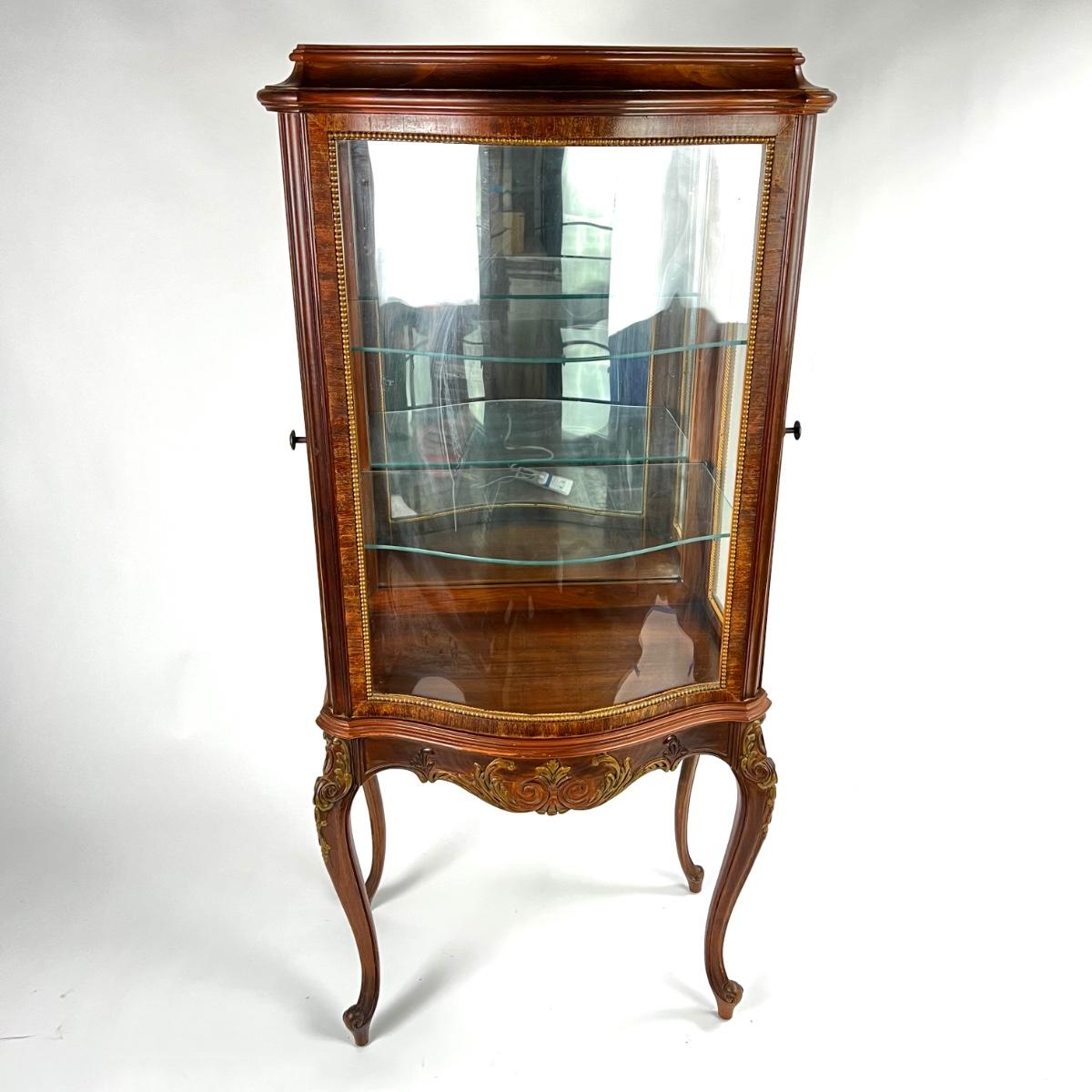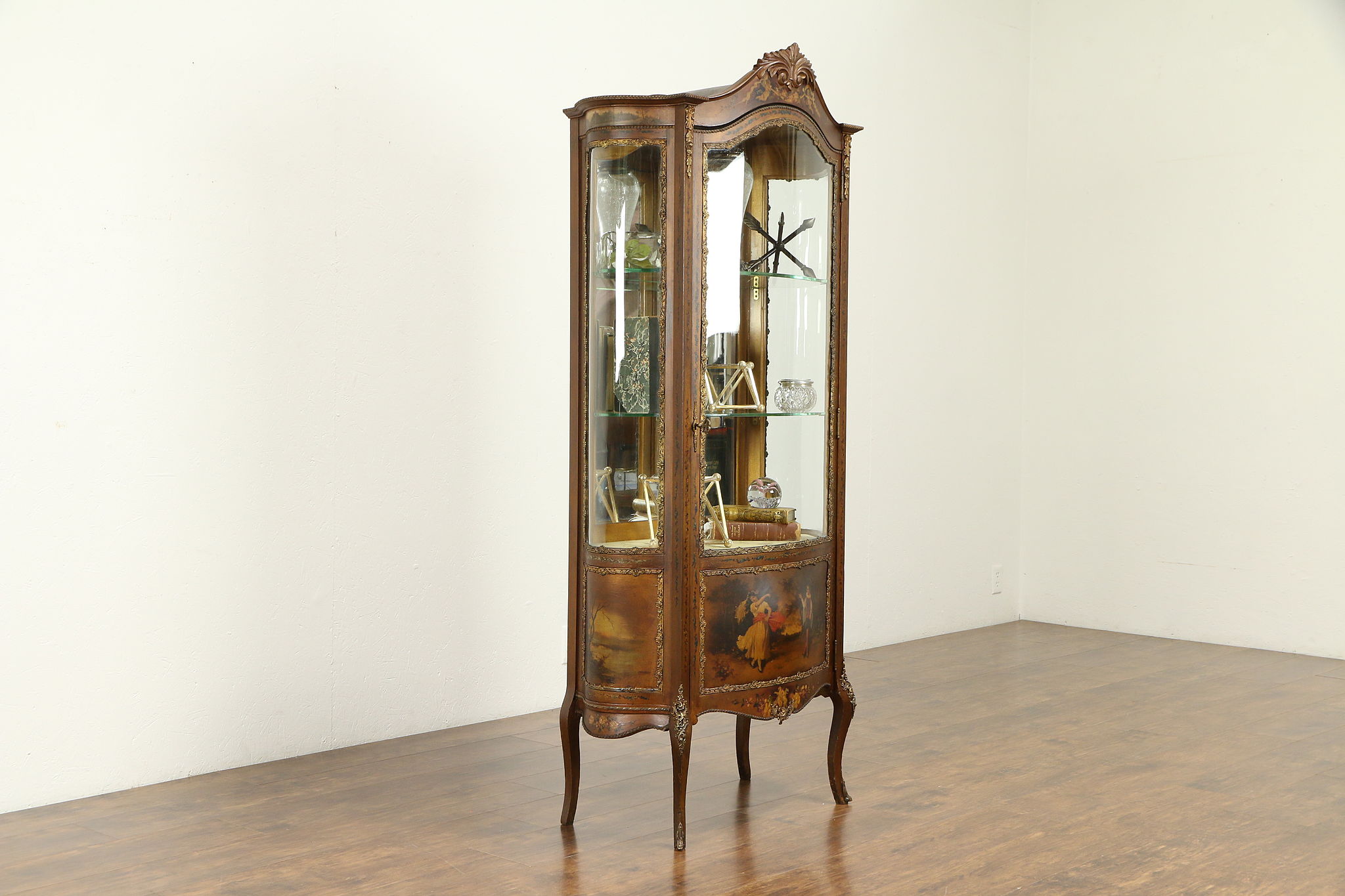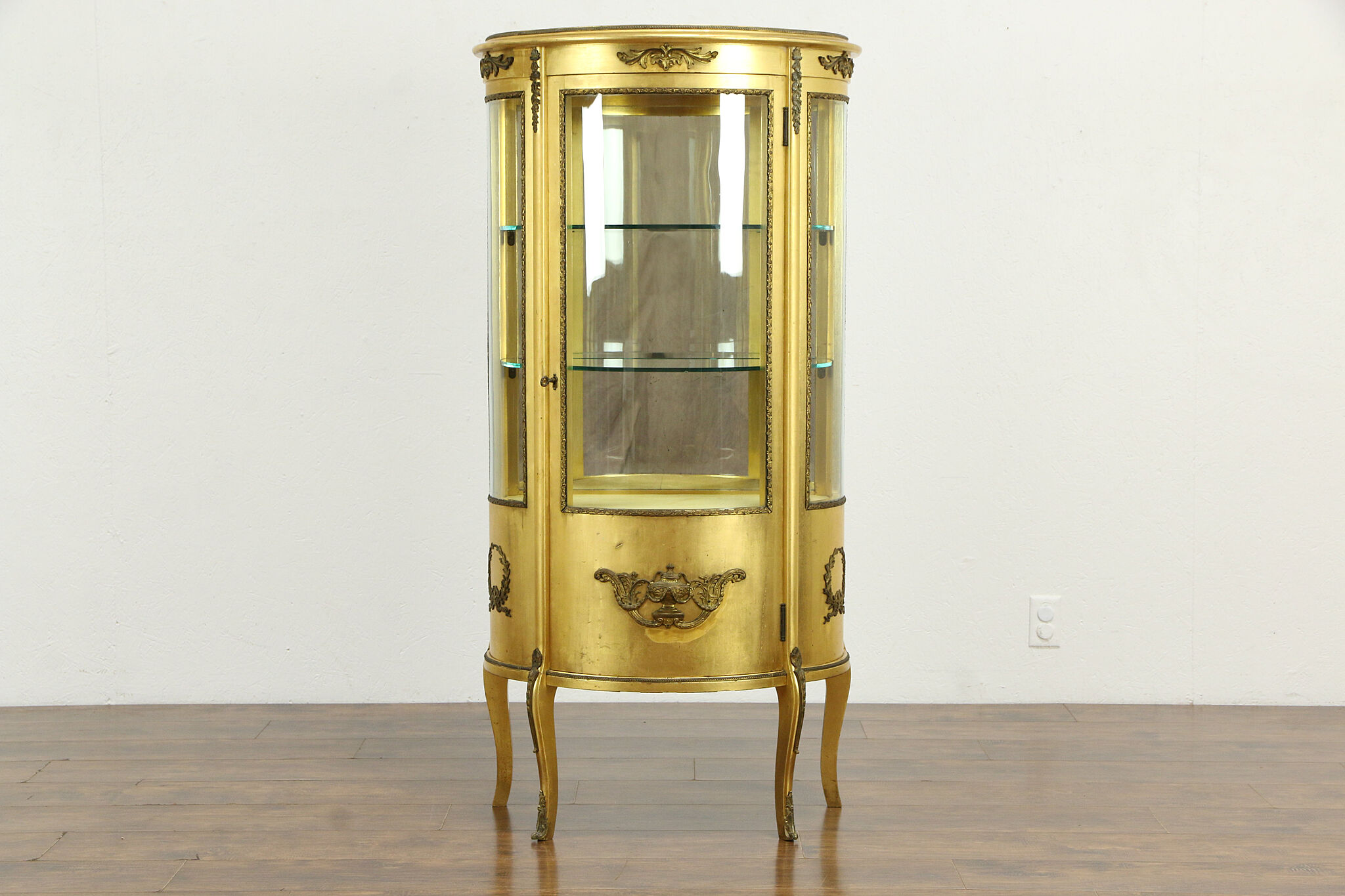History and Origins

French curio cabinets, also known as cabinets of curiosities, have a rich history that spans centuries and reflects the evolution of taste and artistic expression in France. They originated during the Renaissance period, evolving from simple chests and display cases into elaborate and intricate pieces of furniture.
Early Origins and Evolution
The earliest forms of curio cabinets were practical storage solutions, often used by collectors to display their prized possessions. These early cabinets were typically made of wood and adorned with simple carvings or painted designs. During the 16th and 17th centuries, French cabinetmakers began incorporating more elaborate decorative elements, such as inlays, marquetry, and gilded finishes. These decorative techniques were influenced by the influx of exotic materials and artistic styles from across Europe and Asia, as well as the patronage of the French aristocracy.
Craftsmanship and Materials
Antique French curio cabinets are renowned for their exceptional craftsmanship and use of high-quality materials. Cabinetmakers employed a wide range of techniques, including:
- Marquetry: Intricate patterns created by inlaying thin veneers of different woods. This technique was particularly popular in the 18th century and often featured floral motifs, geometric designs, and scenes from mythology.
- Carving: Elaborate carvings were used to adorn the cabinet’s exterior, often featuring intricate details, such as scrolls, foliage, and mythological creatures.
- Gilding: Applying thin layers of gold leaf to the cabinet’s surface, creating a luxurious and shimmering finish.
- Lacquerwork: A technique using a resinous varnish to create a glossy and durable finish. Lacquerwork was often used to decorate cabinets with intricate designs and vibrant colors.
The materials used in antique French curio cabinets varied depending on the period and the cabinetmaker’s preference. Common materials included:
- Oak: A strong and durable hardwood, often used for the cabinet’s frame and structure.
- Walnut: A rich-toned hardwood, often used for marquetry and other decorative elements.
- Mahogany: A luxurious and highly sought-after hardwood, often used for the cabinet’s exterior and interior.
- Ivory: A precious material used for decorative accents, such as handles and inlays.
- Bronze: Used for hinges, locks, and other metal accents.
Notable Cabinetmakers and Styles
Throughout the history of French curio cabinets, several notable cabinetmakers emerged, each with their own distinct style and techniques. Some of the most renowned include:
- André-Charles Boulle (1642-1732): A master of marquetry, Boulle’s cabinets are characterized by their intricate geometric patterns and use of contrasting woods, such as ebony and brass. He was known for his highly sought-after “Boulle work,” a technique that involved inlaying brass and tortoiseshell to create elaborate designs.
- Jean-Henri Riesener (1734-1806): A prominent cabinetmaker during the reign of Louis XVI, Riesener’s work is known for its elegant and refined style. He often used mahogany and other exotic woods, and his cabinets were frequently decorated with intricate carvings, ormolu (gilded bronze), and porcelain plaques.
- David Roentgen (1743-1807): A German-born cabinetmaker who worked in France, Roentgen was known for his innovative designs and use of new materials, such as exotic woods and metal. He created cabinets with hidden compartments, secret drawers, and ingenious mechanisms, reflecting the growing interest in scientific and technological advancements during the Enlightenment.
Styles and Designs

Antique French curio cabinets are not just storage solutions; they are exquisite works of art that reflect the evolving styles and tastes of different eras. Each period in French history has left its unique mark on these cabinets, resulting in a diverse array of designs, materials, and decorative elements.
Louis XIV Style, Antique french curio cabinet
The Louis XIV style, also known as the Grand Siècle, flourished during the reign of King Louis XIV (1643-1715). This period was characterized by opulence, grandeur, and a preference for classical forms. The Louis XIV style is distinguished by its elaborate ornamentation, use of expensive materials, and intricate craftsmanship.
- Ornamentation: Louis XIV cabinets are often adorned with intricate carvings, gilding, and marquetry. Common motifs include acanthus leaves, laurel wreaths, and the royal fleur-de-lis.
- Materials: High-quality materials like mahogany, walnut, and ebony were favored for their rich color and durability.
- Construction: Louis XIV cabinets were meticulously crafted using traditional joinery techniques. They often featured elaborate architectural details, such as pilasters, cornices, and pediments.
Louis XV Style
The Louis XV style, which emerged in the mid-18th century, marked a departure from the formality and grandeur of the previous era. This period embraced a more graceful and elegant aesthetic, characterized by asymmetrical designs, curved lines, and delicate ornamentation.
- Ornamentation: Louis XV cabinets feature more delicate and flowing designs compared to their Louis XIV predecessors. Common motifs include shell-shaped ornaments (rocaille), floral patterns, and playful scrolls.
- Materials: While still using hardwoods like mahogany and walnut, Louis XV cabinets also incorporated lighter woods like cherry and maple, which added a sense of lightness and elegance.
- Construction: Louis XV cabinets often featured curved and serpentine forms, achieved through intricate joinery techniques. They were typically smaller and more intimate than Louis XIV cabinets.
Louis XVI Style
The Louis XVI style, which flourished in the late 18th century, reflected the ideals of the Enlightenment. It emphasized simplicity, order, and a return to classical forms, drawing inspiration from ancient Greek and Roman architecture.
- Ornamentation: Louis XVI cabinets featured more restrained ornamentation compared to earlier styles. Geometric motifs, such as ovals, squares, and circles, were prevalent, along with delicate floral patterns and ribbons.
- Materials: Louis XVI cabinets were often crafted from lighter woods like oak, maple, and cherry. They also incorporated exotic woods like rosewood and satinwood for decorative accents.
- Construction: Louis XVI cabinets were characterized by straight lines, symmetrical designs, and a focus on functionality. They often featured simple, elegant details, such as fluted pilasters and classical moldings.
| Style | Ornamentation | Materials | Construction | Examples |
|---|---|---|---|---|
| Louis XIV | Intricate carvings, gilding, marquetry, acanthus leaves, laurel wreaths, fleur-de-lis | Mahogany, walnut, ebony | Elaborate joinery, architectural details, pilasters, cornices, pediments | A large cabinet with intricate carvings, a display case with a gilded frame |
| Louis XV | Delicate and flowing designs, rocaille, floral patterns, playful scrolls | Mahogany, walnut, cherry, maple | Curved and serpentine forms, intricate joinery, smaller and more intimate | A cabinet with a serpentine front, a display case with delicate floral carvings |
| Louis XVI | Restrained ornamentation, geometric motifs, ovals, squares, circles, floral patterns, ribbons | Oak, maple, cherry, rosewood, satinwood | Straight lines, symmetrical designs, fluted pilasters, classical moldings | A cabinet with a simple, elegant design, a display case with a geometric pattern |
Value and Appreciation: Antique French Curio Cabinet

Antique French curio cabinets, with their intricate craftsmanship and historical significance, have become prized possessions for collectors and enthusiasts. The value of these cabinets is influenced by a range of factors, making each piece unique and potentially valuable.
Factors Influencing Value
The value of an antique French curio cabinet is determined by several key factors. These factors are interrelated and contribute to the overall desirability and price of a cabinet.
- Age and Origin: Older cabinets, particularly those from the 18th and 19th centuries, are generally more valuable due to their rarity and historical significance. Cabinets from renowned regions like Paris or the provinces of Normandy and Provence often command higher prices.
- Material and Construction: The type of wood used, the quality of craftsmanship, and the intricate details of the cabinet’s construction all influence its value. Cabinets made from rare or exotic woods, such as mahogany, walnut, or rosewood, are highly sought after.
- Style and Design: The style of the cabinet, whether it’s Louis XIV, Louis XV, or Louis XVI, plays a significant role in its value. Cabinets with unique designs, such as those incorporating marquetry, ormolu mounts, or painted decorations, are often more valuable.
- Condition: The condition of the cabinet is a crucial factor in its value. Cabinets in excellent condition, with minimal wear and tear, are more valuable than those with damage or restoration.
- Rarity and Provenance: Rare cabinets, those with a documented history or provenance, are highly sought after and can command significantly higher prices.
Examples of Rare and Highly Sought-After Cabinets
Several examples of rare and highly sought-after antique French curio cabinets exist. These cabinets are often featured in auctions and private collections, with estimated values reaching into the tens of thousands, or even hundreds of thousands, of dollars.
- A Louis XV marquetry cabinet: A cabinet crafted in the Louis XV style, featuring intricate marquetry designs and ormolu mounts, could fetch upwards of $50,000. The use of rare woods and the exquisite craftsmanship contribute to its value.
- A Boulle work cabinet: Cabinets attributed to the renowned French cabinetmaker André-Charles Boulle, known for his distinctive marquetry technique using tortoiseshell and brass, are extremely rare and valuable. A Boulle work cabinet in excellent condition could sell for well over $100,000.
- A cabinet from the 18th century: A cabinet dating back to the 18th century, particularly one with a documented provenance, can be incredibly valuable. The historical significance and the rarity of such cabinets make them highly sought after by collectors and museums.
Current Market Trends and Appreciation
The market for antique French curio cabinets remains strong, with a growing appreciation for their historical significance, craftsmanship, and beauty. Demand for these cabinets continues to increase, driven by collectors and enthusiasts who are drawn to their elegance and unique character.
The increasing interest in antique French curio cabinets has resulted in steady price appreciation, making them a valuable investment for discerning collectors.
The current market trend suggests that antique French curio cabinets, especially those in excellent condition and with desirable features, will continue to appreciate in value over time.
Antique French curio cabinets, with their intricate carvings and glass doors, are a testament to the craftsmanship of bygone eras. They’re often filled with delicate porcelain figurines and shimmering crystal, but the same meticulous attention to detail can be applied to modern kitchens.
Consider incorporating slide out spice racks for kitchen cabinets to create a beautifully organized and efficient space, just like the elegant interiors of those antique cabinets. With a little creativity, you can bring a touch of French charm to your own kitchen, whether it’s through the use of vintage-inspired decor or clever storage solutions.
An antique French curio cabinet, with its intricate carvings and glass panes, whispers tales of a bygone era. While these cabinets are often used to display cherished heirlooms, a modern twist can be achieved by incorporating a corner cabinet pot rack inside.
This practical addition adds functionality, allowing you to showcase your favorite cookware while maintaining the cabinet’s elegant aesthetic.
